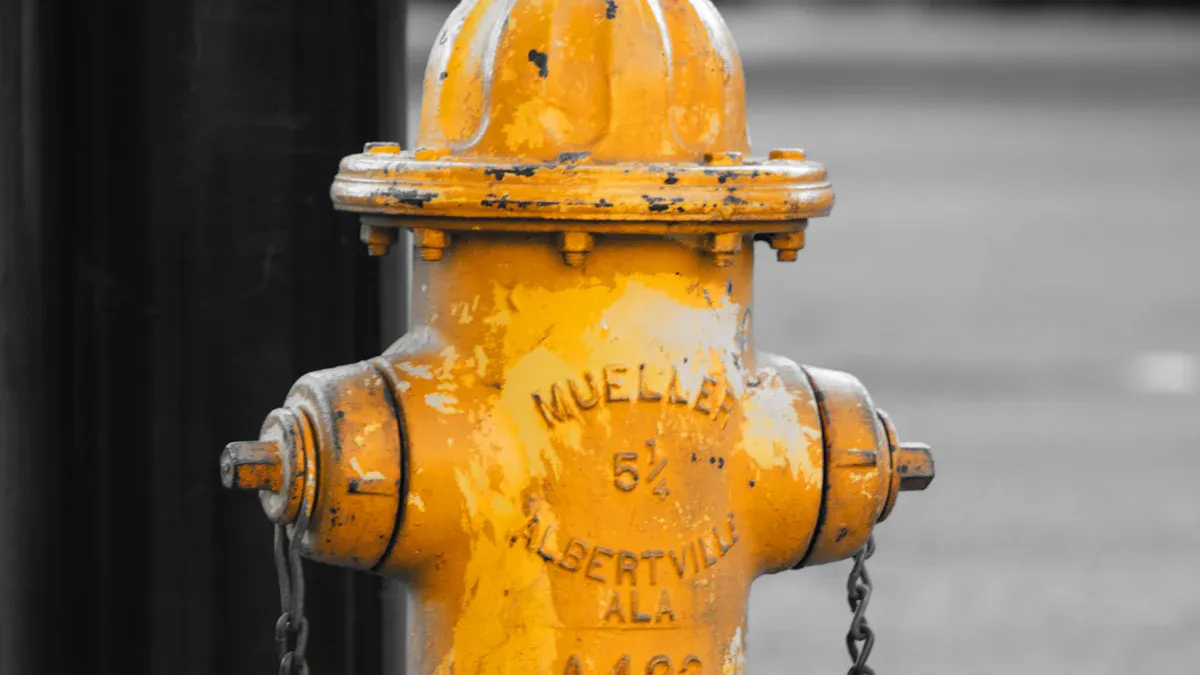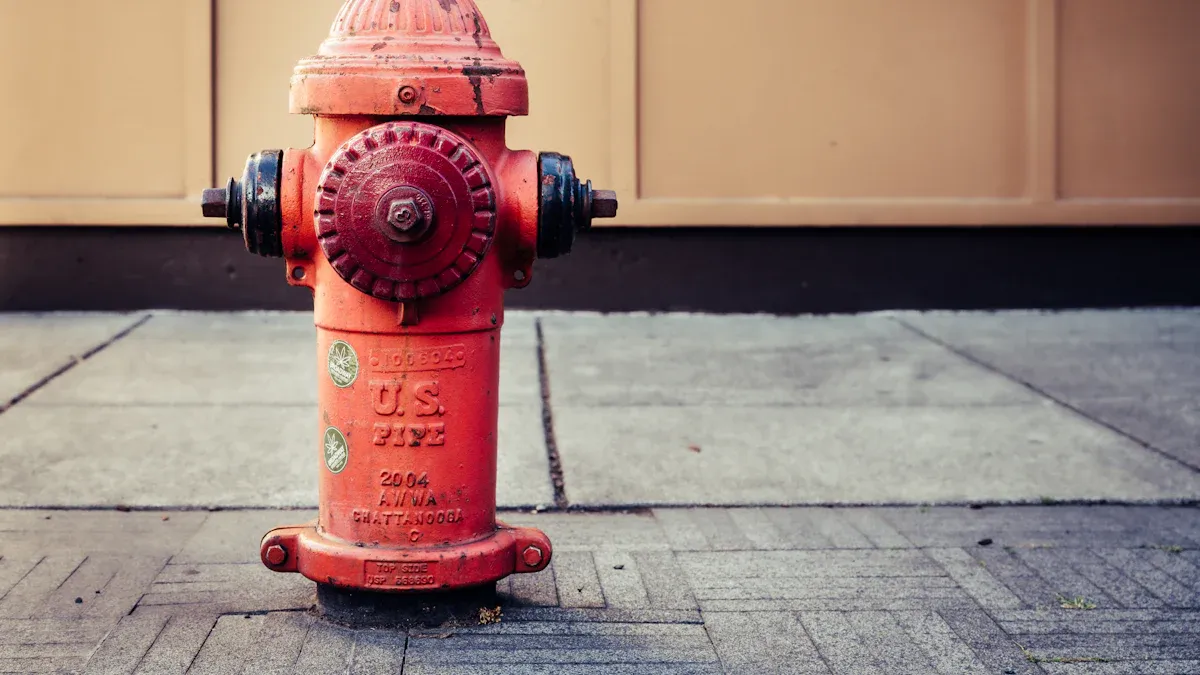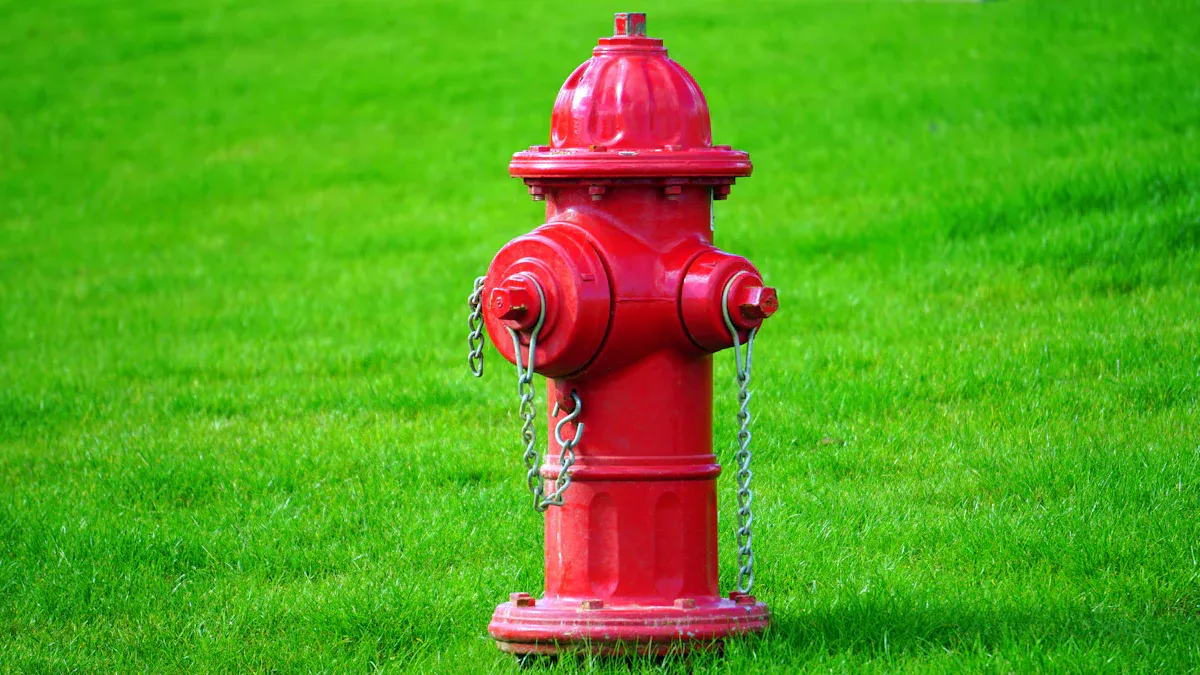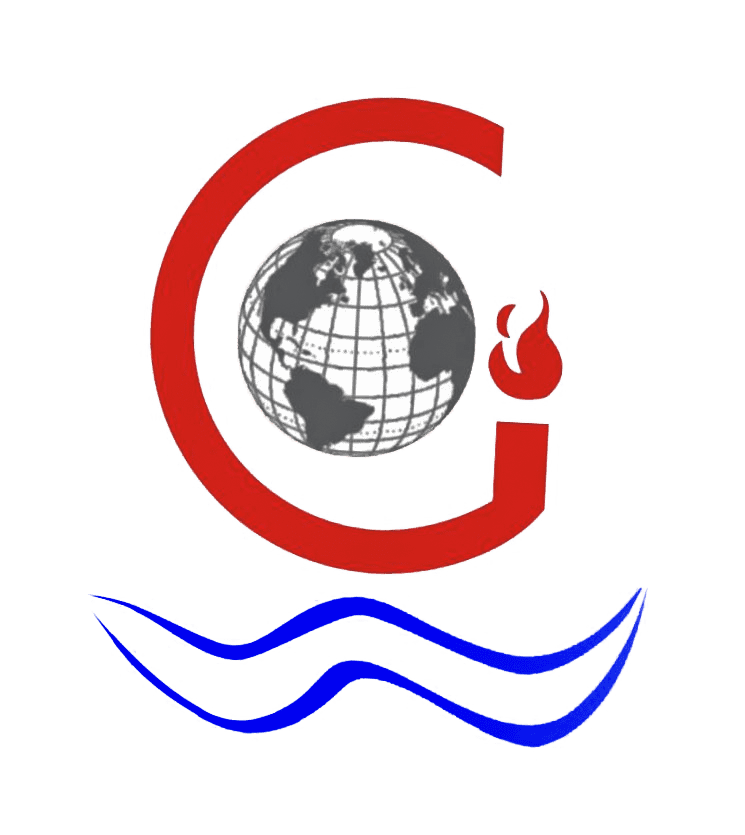
Proper installation of a Fire ExtinguisherPillar Fire Hydrant is crucial for ensuring the safety of commercial complexes. These systems are vital in managing fire emergencies, enabling swift responses, and reducing property damage. A strategically positioned Fire Hydrant equipped with a dependable Fire Hydrant Valve and an easily accessible Fire Hose Reel&Cabinet allows emergency teams to respond effectively. Following proper installation guidelines not only enhances safety but also ensures compliance with regulatory standards, safeguarding lives and property.
Yuyao World Fire Fighting Equipment Factory offers premium Fire ExtinguisherPillar Fire Hydrants, Fire Hydrants, Fire Hydrant Valves, and Fire Hose Reel&Cabinet solutions, all designed for durability and optimal performance to meet safety requirements.
Key Takeaways
- Check the area carefully before setting up hydrants. This helps place them where they are easy to see and use.
- Get the needed permits and approvals to follow local fire rules. This avoids problems and keeps everything legal.
- Test and fix hydrants often to make sure they work in emergencies. Do checks every month and full tests once a year.
- Teach workers how to use hydrants and handle emergencies. Trained staff can act fast and help during fires.
- Update hydrant systems when needed to match safety rules. This makes them more reliable and keeps up with new laws.
Pre-Installation Steps for Fire Extinguisher Pillar Hydrants
Conducting a Comprehensive Site Assessment
A thorough site assessment lays the foundation for a successful Fire Extinguisher Pillar Fire Hydrant installation. Evaluating the area ensures the system meets safety and operational requirements. Key steps include:
- Ensuring the water supply connects adequately to the water mains.
- Marking hydrant locations with proper signage for visibility.
- Scheduling regular maintenance and inspections to maintain functionality.
Additionally, hydrants should be spaced no more than 500 feet apart and positioned at a standard height of 18 inches above the ground. Conducting a detailed assessment of the area helps identify optimal hydrant locations, considering proximity to buildings and accessibility for firefighting vehicles. These measures ensure the hydrants remain visible, accessible, and free from obstacles.
Obtaining Permits and Approvals
Securing permits and approvals is a critical step in the installation process. Regulatory benchmarks ensure the system complies with local fire safety codes. The following table outlines essential requirements:
| Section | Requirement |
|---|---|
| 407.4 | Training for personnel handling hazardous materials, including emergency response procedures. |
| 407.5 | Submission of a hazardous materials inventory statement (HMIS) when required. |
| 407.6 | Inclusion of a hazardous materials management plan (HMMP) in permit applications as needed. |
| 4604.3 | Provision of fire apparatus access roads and water-supply systems with hydrants as required. |
Collaborating with local authorities and submitting the necessary documentation ensures compliance and avoids delays in the installation process.
Designing a Compliant Fire Hydrant System
Designing a compliant system involves adhering to strict safety and operational standards. Testing water pressure, flow rate, and valve operation ensures the system meets design specifications. Certification from relevant authorities or third-party inspectors is essential after installation and testing. Proper documentation of compliance with regulatory standards is also required.
Collaboration with fire safety professionals and regulatory authorities enhances the effectiveness of the Fire Extinguisher Pillar Fire Hydrant system. This partnership ensures the system is designed to handle emergencies efficiently while meeting all legal requirements.
Fire Extinguisher Pillar Hydrant Installation Process

Preparing the Installation Site
Proper preparation of the installation site ensures the Fire Extinguisher Pillar Fire Hydrant functions effectively during emergencies. The process begins with verifying that the water supply meets the required pressure and flow rate. This involves submitting evidence of water main conditions to the Fire Department. Preliminary plans, detailing the standpipe system layout, must also be approved by the Fire Commissioner before installation begins.
The following table outlines key preparation requirements:
| Requirement | Description |
|---|---|
| Water Supply Evidence | Evidence establishing that water main conditions and pressures meet requirements must be submitted to the Fire Department. |
| Approved Plans | Preliminary plans must be submitted and approved by the Fire Commissioner before installation begins, detailing the standpipe system layout. |
| System Testing | Standpipe systems must be tested for at least half an hour at specified pressures in the presence of a Bureau of Fire Prevention representative. |
| Device Approval | All equipment must bear the manufacturer’s name and approval details, with certified copies submitted to the relevant authority for records. |
Once these steps are completed, the site must be cleared of debris and obstacles to ensure a smooth installation process. Proper preparation minimizes delays and ensures compliance with fire safety regulations.
Installing Pipes, Valves, and Controls
The installation of pipes, valves, and controls forms the backbone of the Fire Extinguisher Pillar Fire Hydrant system. Adhering to technical standards ensures the system operates efficiently and reliably. For instance, NFPA 24 provides guidelines for installing private fire service mains and hydrants, while NFPA 291 offers recommendations for fire flow testing and hydrant marking.
The table below highlights key technical specifications:
| Standard | Description |
|---|---|
| NFPA 24 | Standard for the Installation of Private Fire Service Mains and Their Appurtenances, detailing installation of fire service main piping and hydrants. |
| NFPA 291 | Recommended Practice for Fire Flow Testing and Marking of Hydrants, providing guidance on fire flow tests and hydrant color-coding. |
| AWWA C502 | Establishes minimum requirements for dry-barrel fire hydrants used in water supply service. |
| AWWA C550 | Pertains to protective epoxy interior coatings for valves and hydrants, ensuring longevity and safety. |
| International Building Code (IBC) | Comprehensive building code with provisions related to fire hydrants and fire protection. |
| International Fire Code (IFC) | Covers general fire prevention regulations and fire protection requirements for buildings and facilities. |
During installation, all components must be inspected for defects and certified for safety. Proper alignment of pipes and secure connections between valves and controls are critical to prevent leaks and ensure optimal water flow.
Positioning and Securing the Pillar Hydrant
Positioning the Fire Extinguisher Pillar Fire Hydrant correctly is essential for accessibility and functionality. Hydrants should be spaced no more than 500 feet apart to provide adequate coverage. They must remain visible and accessible, avoiding placement behind obstacles such as fences or parked vehicles.
Key guidelines for positioning and securing hydrants include:
- Install hydrants at a standard height of 18 inches above the ground.
- Connect each hydrant to a water main with sufficient flow rate and pressure.
- Clearly mark hydrants and designate the surrounding area as a no-parking zone.
- Protect hydrants in cold regions with insulation or heating systems to prevent freezing.
- Conduct regular maintenance and inspections to ensure long-term functionality.
Proper anchoring of the hydrant to a stable foundation prevents movement during operation. These measures ensure the hydrant remains operational and accessible during emergencies, enhancing the safety of the commercial complex.
Connecting the Hydrant to the Water Supply
Connecting the Fire Extinguisher Pillar Fire Hydrant to the water supply is a critical step in ensuring the system’s reliability during emergencies. This process demands precision and adherence to established guidelines to maintain consistent functionality and meet safety standards.
To begin, technicians must evaluate the water supply’s capacity and reliability. Historical flow tests offer valuable insights into the performance of water sources, helping to predict their ability to meet future demands. These tests also highlight potential issues, such as pressure drops or flow inconsistencies, that could compromise the hydrant’s effectiveness. Adjustments to the system should account for variability in water supply conditions, as factors like seasonal changes or infrastructure updates can impact performance.
A well-established design basis water supply forms the foundation of an effective fire protection system. This ensures the hydrant can deliver adequate water flow and pressure during emergencies. Technicians must connect the hydrant to the main water line using durable, corrosion-resistant materials to prevent leaks and ensure longevity. Proper sealing of joints and fittings is essential to avoid water loss and maintain system integrity.
During the connection process, it is vital to monitor the system for leaks and verify that the water pressure meets the required specifications. Testing the hydrant under operational conditions ensures it can handle the demands of a real emergency. Regular monitoring and maintenance further enhance the system’s reliability, allowing it to perform optimally when needed.
Yuyao World Fire Fighting Equipment Factory provides high-quality solutions for Fire Extinguisher Pillar Fire Hydrant systems, ensuring durability and compliance with industry standards. Their expertise in fire safety equipment supports the seamless integration of hydrants into water supply systems, safeguarding commercial complexes against fire hazards.
Best Practices for Fire Extinguisher Pillar Hydrant Placement

Ensuring Proper Spacing and Coverage
Proper spacing and coverage are critical for the effective operation of a Fire Extinguisher Pillar Fire Hydrant system. Hydrants must be strategically placed to ensure they provide adequate coverage for the entire commercial complex. Industry standards recommend spacing hydrants no more than 500 feet apart. This distance allows firefighters to access water quickly during emergencies.
To determine optimal placement, professionals should evaluate the layout of the property. Key considerations include the size of the complex, the location of high-risk areas, and the accessibility of water mains. A well-planned layout ensures that hydrants are within reach of firefighting equipment and personnel.
Tip: Conducting a hydraulic analysis can help identify areas with insufficient water pressure or flow. This ensures that hydrants in those locations meet operational requirements.
Maximizing Visibility and Accessibility
Visibility and accessibility play a vital role in the functionality of fire hydrants. Hydrants must remain unobstructed and easy to locate, even in low-visibility conditions. Brightly colored paint, reflective markers, and clear signage can enhance visibility. These measures help firefighters locate hydrants quickly during emergencies.
Accessibility requires careful planning. Hydrants should not be placed behind fences, parked vehicles, or landscaping features. A clear radius of at least three feet around each hydrant ensures that firefighting teams can connect hoses and operate valves without hindrance.
Note: In regions prone to snow, hydrants should be equipped with markers or flags that remain visible above snowdrifts. This precaution ensures accessibility throughout the year.
Adhering to Local Fire Safety Regulations
Compliance with local fire safety regulations is essential for the installation and placement of hydrants. Authorities often specify requirements for hydrant spacing, water pressure, and maintenance schedules. Adhering to these regulations ensures the system meets legal standards and provides reliable protection.
A thorough review of local codes and standards should guide the placement process. For example, some jurisdictions may require hydrants to be installed at specific heights or distances from roadways. Collaborating with fire safety officials during the planning phase can help address these requirements.
Callout: Non-compliance with fire safety regulations can result in fines, delays, or system malfunctions. Regular inspections and updates ensure continued adherence to these standards.
Yuyao World Fire Fighting Equipment Factory offers expert guidance and high-quality solutions for Fire Extinguisher Pillar Fire Hydrant systems. Their products and services ensure compliance with industry standards while enhancing the safety of commercial complexes.
Post-Installation Steps for Fire Extinguisher Pillar Hydrants
Testing and Verifying System Functionality
Testing ensures the Fire Extinguisher Pillar Fire Hydrant operates effectively during emergencies. Technicians must conduct pressure and flow tests to confirm the system meets design specifications. These tests simulate real-world conditions, verifying the hydrant’s ability to deliver adequate water supply.
A step-by-step approach enhances accuracy:
- Inspect all connections for leaks or defects.
- Measure water pressure and flow rate using calibrated equipment.
- Operate valves and controls to confirm smooth functionality.
Technicians should document test results and address any discrepancies immediately. Regular testing builds confidence in the system’s reliability and ensures compliance with safety standards.
Tip: Schedule periodic re-tests to maintain optimal performance over time.
Obtaining Certification and Compliance Approval
Certification validates that the hydrant system adheres to local fire safety regulations. Authorities or third-party inspectors evaluate the installation, ensuring it meets all legal and operational requirements.
The process involves:
- Submitting test results and system documentation to regulatory bodies.
- Scheduling on-site inspections to verify compliance.
- Addressing any corrective actions recommended by inspectors.
Once approved, the system receives certification, confirming its readiness for emergencies. Maintaining this certification requires adherence to inspection schedules and prompt updates to meet evolving standards.
Training Staff on Proper Hydrant Usage
Training equips staff with the knowledge to operate the hydrant system effectively. Fire safety professionals should conduct hands-on sessions, demonstrating proper techniques for connecting hoses, operating valves, and managing water flow.
Key training topics include:
- Identifying hydrant components and their functions.
- Following safety protocols during emergencies.
- Reporting maintenance issues promptly.
Regular training sessions reinforce skills and ensure preparedness. Well-trained staff contribute to faster response times and improved safety outcomes during fire incidents.
Callout: Yuyao World Fire Fighting Equipment Factory offers expert guidance and reliable solutions for Fire Extinguisher Pillar Fire Hydrant systems, ensuring safety and compliance for commercial complexes.
Maintenance and Inspection of Fire Extinguisher Pillar Hydrants
Establishing Regular Inspection Schedules
Regular inspections ensure fire extinguisher pillar hydrants remain functional and compliant with safety standards. Scheduling inspections at consistent intervals helps identify potential issues before they escalate. Professionals recommend monthly visual checks and annual performance tests to verify water pressure, flow rate, and valve operation.
Inspection schedules should prioritize high-risk areas within commercial complexes. Hydrants near hazardous materials or densely populated zones require more frequent evaluations. A systematic approach ensures all hydrants receive attention, minimizing the risk of malfunction during emergencies.
Tip: Collaborate with certified fire safety experts to establish inspection protocols tailored to the specific needs of the property.
Cleaning and Repairing Hydrant Components
Cleaning and repairing hydrant components extend their lifespan and maintain optimal performance. Dirt, debris, and corrosion can obstruct water flow and compromise functionality. Regular cleaning prevents buildup and ensures smooth operation.
Repairing damaged components requires prompt action. Technicians should replace worn-out valves, seals, and gaskets to prevent leaks. Maintaining detailed records of all inspections, maintenance, and repairs validates ongoing upkeep and compliance.
| Evidence Type | Description |
|---|---|
| Record Keeping | Detailed records of all inspections, maintenance, and repairs must be maintained. |
| Compliance | These records are crucial for demonstrating compliance with regulations and tracking performance. |
- Accurate documentation is essential for effective maintenance.
- Records provide a comprehensive history of condition and performance.
- Well-documented maintenance records demonstrate adherence to safety requirements.
Upgrading Systems to Meet Current Standards
Upgrading hydrant systems ensures they meet evolving safety standards and technological advancements. Modern systems offer improved durability, efficiency, and compatibility with firefighting equipment. Upgrades may include installing advanced valves, enhancing water pressure capabilities, or integrating smart monitoring systems.
Technicians should evaluate the system’s performance against current standards, such as NFPA guidelines and local fire codes. Historical data on hydrant usage and maintenance can inform upgrade decisions. Regular updates enhance reliability and ensure the system remains compliant with industry requirements.
Callout: Yuyao World Fire Fighting Equipment Factory provides cutting-edge solutions for upgrading fire extinguisher pillar hydrant systems, ensuring safety and compliance for commercial complexes.
Proper installation, strategic placement, and regular maintenance of fire extinguisher pillar hydrants are essential for safeguarding commercial complexes. These measures ensure the system operates effectively during emergencies, protecting lives and property. Adhering to industry best practices and local fire safety regulations enhances reliability and compliance.
Tip: Collaborate with experienced professionals to ensure your fire safety systems meet the highest standards.
Yuyao World Fire Fighting Equipment Factory offers expert guidance and high-quality solutions. Their expertise ensures seamless installation, thorough inspections, and long-term system performance. Consulting their team guarantees peace of mind and optimal fire safety for your property.
FAQ
What is the recommended distance between fire extinguisher pillar hydrants?
Industry standards suggest placing hydrants no more than 500 feet apart. This spacing ensures adequate coverage and quick access for firefighting teams. Proper placement enhances safety and minimizes response time during emergencies.
How often should fire extinguisher pillar hydrants be inspected?
Monthly visual inspections and annual performance tests are recommended. These checks verify water pressure, flow rate, and valve functionality. Regular inspections ensure the hydrants remain operational and compliant with safety standards.
Tip: Collaborate with certified fire safety professionals to establish a tailored inspection schedule.
Can fire extinguisher pillar hydrants operate in freezing conditions?
Yes, hydrants can function in freezing conditions when equipped with protective measures. Insulation, heating systems, or dry-barrel designs prevent freezing. These features ensure reliable operation in cold climates.
What materials are best for hydrant connections?
Durable, corrosion-resistant materials like ductile iron or brass are ideal for hydrant connections. These materials prevent leaks, ensure longevity, and maintain system integrity under high-pressure conditions.
Why is staff training important for hydrant systems?
Training equips staff with the skills to operate hydrants effectively during emergencies. It covers connecting hoses, managing water flow, and following safety protocols. Well-trained personnel improve response times and enhance overall safety.
Callout: Yuyao World Fire Fighting Equipment Factory offers expert guidance and training resources for hydrant systems.
Post time: Apr-30-2025

